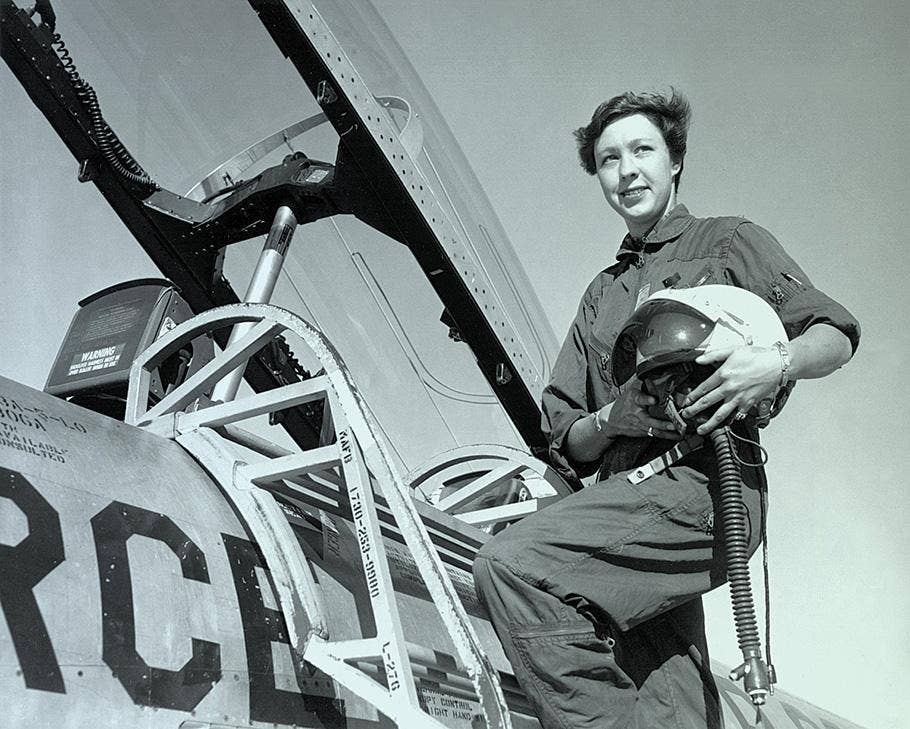The Future of Aviation Is Steam Power
With viable electric aircraft for flight training still years away, what’s the real alternative fuel?

The fatal flaw standing in the way of effective use of electric-powered aircraft is very well understood and easily summed up in two words: energy density. [Photo: Air]
Attention, investors: I’ve decided to design and build an airplane powered entirely by steam engine. The target market for such an aircraft is, of course, flight schools and any pilots looking to avoid the high cost of avgas by chopping their own firewood. Exciting, huh? I’m just a few years from building my conforming prototype and looking for investors with an insatiable appetite for socially responsible nonsense and too polite to wonder out loud how long it takes the boiler to build up a head of steam.
Yeah, sticks of wood are a kind of fossil fuel, but they are unleaded, so my engine is definitely greener than yours, sort of. And yes, a steam engine can spin a propeller. Now, enough of your pesky questions.
If you think my idea is just too dumb to invest in, then you haven’t been following what’s happening with electric aircraft, an investor-targeted fraud not unlike the Theranos mess from just a few years ago. For those not familiar with the name Theranos, suffice to say hundreds of millions of investor dollars were squandered on what appeared to be a beneficial idea with no hope of ever delivering a usable product or a return to investors. Of course, investment in less-than-great ideas happens all the time—think timeshare—but what makes Theranos and electric aircraft development stand out is how, while in the process of gathering and dispersing millions, they manage to avoid even a cursory level of skeptical review. For the most part, the coverage is breathlessly positive, merely reprints of glossy press releases in an impressive show of “suspension of common sense.”
Do electric airplanes fly? Well, of course they do! We’ve known that since the early 1970s. Spin a propeller fast enough, even if you use a giant rubber band to do it, and you’ll create enough thrust to get a light airplane off the ground. The fatal flaw—that single thing standing in the way of effective use of electric powered aircraft—is very well understood and easily summed up in two words: energy density.
Before I go on, a small confession. About eight or nine years ago, I invested a large sum in an electric aircraft company that promised to have a prototype flying within two to three years. Naturally, that didn’t happen. About five years in, they hung an electric motor on a kitplane and hauled it around to events like EAA AirVenture in a shockingly successful search for more investors. Ten years have gone by now and that company is in the process of building a conforming prototype, they say. While these guys may not be good at building airplanes, they are absolute savants at issuing press releases. Appearing at an average rate of about one a week, a third of them announce the selection of some parts supplier, a third discuss details of future versions of an airplane they haven’t yet built, and the rest proudly announce that this or that university or organization has “committed” to buy their electric airplanes for their training fleets.
This last group is a bit of a mystery to me. Beyond the obvious social credits a university might receive for embracing electric over gasoline, one has to wonder what type of spreadsheet gymnastics they had to perform to justify investing in a fleet of aircraft two or three times larger than the fleet they operate today. More on why that’s true later.
The amount of energy that can be stored and released on demand, be it in a battery or avgas or a twisted rubber band, per unit of mass is known as specific energy.
“Es = E/m”
What this means is, the higher the specific energy, the more energy you will get out of a pound of whatever it is you’re storing it in. This is the “fatal flaw” I mentioned earlier. The specific energy of 100LL avgas is about 47, while the best lithium-ion battery around is about 1. Put another way, 10 pounds of battery will store 1,200 watt/hours of energy while 10 pounds (1.66 gallons) of 100LL contains 48,000 watt/hours. No clue on the rubber band.
“A fully-fueled Boeing 787-10 Dreamliner can fly roughly 8,000 miles while ferrying 300 or so passengers and their luggage. A battery with the energy equivalent to that fuel would weigh about 6.6 million pounds.”
Let’s look at this in real-world terms. We’ll use a Cessna 172 for this because the performance specs are well-known and it represents the optimal flight-training platform. Fuel capacity on a 172 is about 56 gallons weighing 336 pounds. Its engine, a Lycoming IO-360, weighs about 260 pounds. Cruising at 75 percent power, we can fly about five hours before the engine gets quiet. With max fuel aboard, that leaves us with about 500 pounds of useful load, or three medium-sized adults with no bags. If we replaced the avgas and engine with 550 pounds of fully charged lithium-ion batteries and a 50-pound electric motor, our cruise time to exhaustion drops to an hour and 20 minutes. Not terrible for many training scenarios, but that 80 minutes assumes we’re not flying at night, that the temperature is not dropping as we climb, we’re keeping our radio transmissions to a minimum, and the airplane is not booked for two-plus hours after we get back because it’s going to take at least that long to recharge the batteries. Oh yes, one other thing: We’re not flying anywhere north of Missouri in January because we may freeze to death.
“Need to carry a fourth passenger on a conventional 172? No problem. Reduce the fuel load. Need a fourth passenger on an electric 172? Ah...no.”
Picture, for a moment, flight training in North Dakota in winter. According to a Forbes article, the batteries in Tesla automobiles lose at least 30 percent of their range once the temperature nears 0 degrees Fahrenheit. Eighty minutes of flight time immediately goes down to 56, assuming you don’t attempt to heat the cabin—barely enough time for a complete flight lesson, but plenty of time for a good old-fashioned case of frostbite.
Inside the lithium batteries, ions are traveling between the positive and negative electrodes through a liquid electrolyte. As it gets colder, the liquid becomes thicker, resistance goes up, and the ions move more slowly. The more the resistance goes up, the faster you lose power. To deal with this, you have to keep the battery warm somehow, but the battery itself is where heat comes from.
High temperatures also cut into battery range. According to tests run on electric cars, at 95 degrees, the range dropped 4 percent without use of air conditioning, and fell by 17 percent when the cabin was cooled. This is a sloppy way to estimate the effects on electric airplanes, and I’d use the battery stats from the electric airplane manufacturers if I could get them, but they’re not sharing.
The wonderful thing about the internal combustion engine on a 172—besides its ability to go from Dallas to Atlanta in a single hop and then on to Philadelphia after a 15-minute refuel—is it makes enough heat to keep the cabin warm whenever needed. Fossil fuel engines make all kinds of beneficial “byproducts” such as electricity for lights, avionics, autopilots, pitot heat and air conditioning, cabin pressurization for high-altitude flight, and a means to drive hydraulic and vacuum pumps without reducing range.
So, are there workable solutions for electric airplanes on the horizon? Well, that depends on how tall a mountain you’re standing on. For airplanes, at least, it’s going to have to be something other than lithium-ion batteries. Energy density in these batteries is quickly reaching its theoretical limit, which means that more storage will only come in bigger and heavier packages. Bigger and heavier works fine for cars, to a point, but does nothing to improve time aloft. This is a game of diminishing returns wherein tripling the batteries in a 172 would actually reduce the endurance and take the airplane well over its max gross weight.
The most promising short-term improvement appears to be the development of solid-state batteries. Where lithium-ion batteries have a liquid electrolyte, solid state batteries use a solid metal composition as their ion transport mechanism. This switch has a number of benefits, including a higher safety profile in that they are less likely to catch fire, can be made without costly materials like cobalt and nickel, and feature twice the energy density of the lithium-ion batteries. Problem is, besides the fact that doubling the available energy is still not enough, these solid-state batteries are too expensive to use at current production rates. Making our way down the cost curve will take a long time, perhaps 10 years or more, while the industry looks to add customers that are as weight sensitive as aviation.
Farther down the road, for aviation anyway, is the promise of hydrogen fuel cells. You can use hydrogen to spin a propeller, either by running it through an existing internal combustion engine just like it was avgas, or you can use it to fuel a chemical reaction that makes electricity. Hydrogen has a specific energy about one-fourth of jet-A, not bad, and its only byproduct from a fuel cell is water. There are cars and buses already using this technology, and there are even a few experimental aircraft using a hybrid version, meaning they also carry batteries to supplement high-power requirements during takeoff. There are lots of technical issues to work out, of course, like bigger, heavier fuel tanks that would be located in the fuselage instead of the wings, producing enough electrical output to get rid of the batteries, and an infrastructure to store and deliver the hydrogen into the airplane. Big problems, indeed, but the biggest of all is the high cost of actually producing the hydrogen. Without getting too far into the weeds here, it takes a lot of electrical energy to make liquid hydrogen, meaning more generating plants burning fossil fuels, wind and solar farms, and more nukes. Practical applications for aviation, 10 years-plus.
The shame here is that the people writing the press releases about the imminent arrival of fleets of electric aircraft, making promises about capability and delivery dates, know that they are … ummm, (what’s a polite word for lying?). For the Boeings and the Airbuses and the other deep-pocket companies, the cost of funding this research is well worth the PR alone. For the training institutions expressing interest in adding electric aircraft to their programs, I would chalk this up to a combination of wishful thinking and an honest interest in the preservation of the environment. For the rest, those tapping investors that will never see their money returned, I take it they don’t believe in karma.
So, that’s it then. Steam. As long as there are investors out there that are willing to drop millions on electric, I’d say my chances of finally getting that Ferrari are pretty darn good. So, how’s this for a slogan?
“STEAM, NOT A BETTER IDEA, BUT NOT MUCH WORSE.”
Editor's Note: The opinions expressed by the writer are theirs alone and do not necessarily reflect those of FLYING Media Group.

Sign-up for newsletters & special offers!
Get the latest FLYING stories & special offers delivered directly to your inbox






